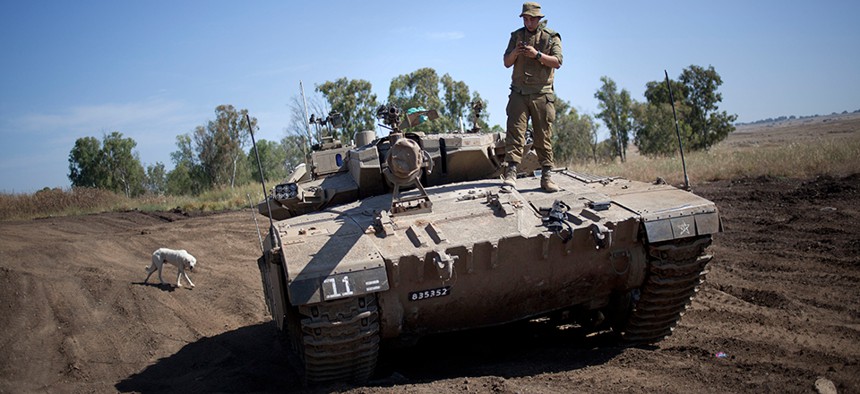
Ariel Schalit/AP
In The Tank: This Week’s Best Defense and National Security Think Tank Offerings
The latest in wonk reads on national security, tech, and more. By Kedar Pavgi
Welcome to “In the Tank”, Defense One’s weekly think tank roundup. Every week, we’ll present the latest research published by think tanks from around the world on defense, national security, foreign policy, technology, and management – a tool to help the national security community navigate the future. If you’d like to submit your latest research, email Kedar Pavgi at webmaster@defenseone.com.
Creating an Environment Conducive to Progress in Israeli-Palestinian Peace Talks
Center for American Progress
Matthew Duss
Secretary of State John Kerry recently announced a new series of talks intended to restart the peace process between Israel and Palestine. To lead this massive endeavor, the administration appointed Clinton-era diplomat and Brookings Institution scholar Martin Indyk to guide the process along. Matthew Duss at the Center for American Progress proposes several ways to maximize the outcome of the talks, while also providing a guide as the administration works with the parties involved. While the issue may be among a series of topics on the minds of policymakers, Duss says that addressing it will make the U.S. response to other crises in the Middle East much easier.
The Evolution of Precision Strike
Center for Strategic and Budgetary Assessments
Barry Watts
Following the end of the Cold War, analysts predicted that the United States and Russia would embrace precision strikes as a major component of military operations. That forecast didn’t come to fruition, but CSBA Senior Fellow Barry Watts says that new technological developments from China are adding another dimension to this form of combat. He goes into the factors defense leaders will need to consider as other countries also begin developing precision strike capabilities, and also discusses the efficacy of existing and future weapons systems. Watt argues that current means of power projection, including the use of carriers, will need to make way for short-range systems based out of locations in the Western Pacific as the United States prepares for possible conflict with China.
Iran: How a Third Tier Cyber Power Can Still Threaten the United States
The Atlantic Council
Barbara Slavin and Jason Healey
Hasan Rouhani recently took over as Iran’s new president, and there are signs that his approach to the United States and the West will be different than that of his predecessors. Even so, policymakers are still concerned about possible threats from Iran, and are assessing the state’s nuclear and conventional capabilities. This paper goes into the impact Iran could have if its military cyber units launched an attack on a commercial facility, such as a stock exchange. Although Iran’s cyber capabilities may not be on par of that of other states, the authors warn that the country has been factoring in cyber attacks as part of their strategic planning.
Half Lives: A Preliminary Assessment of China’s Nuclear Warhead Life Extension and Safety Program
Project 2049 Institute
Ian Easton and Mark Stokes
How capable is China’s nuclear warhead life extension and reliability program? Ian Easton and Mark Stokes investigate the organizational structure behind China’s nuclear weapons program, the prominent figures leading in this area, and the logistics that support the country’s capabilities in this arena. Through a preliminary investigation, they find that China faces significant challenges, both budgetary and management related, in their goal to keep nuclear weapons updated and safe.
Community Self-Protection Strategies: How Peacekeepers Can Help or Harm
Stimson Center
Aditi Gorur
Newly minted U.N Ambassador Samantha Power criticized the U.N. Security Council’s inability to effectively address the conflict in Syria, but this paper looks into ways that blue helmet clad troops can help support self-protection programs in conflict zones. With U.S. troops having supported major peacekeeping operations in the past, this topic is especially pertinent to help increase the efficacy of these operations in the future. Aditi Gorur at the Stimson Center says peacekeepers often do not consider how their presence might augment current self-protection programs, and often undermine strategies laid out by local communities. The paper relies on research done in the Democratic Republic of Congo, along with numerous interviews conducted with civil society groups and community leaders in the country.




